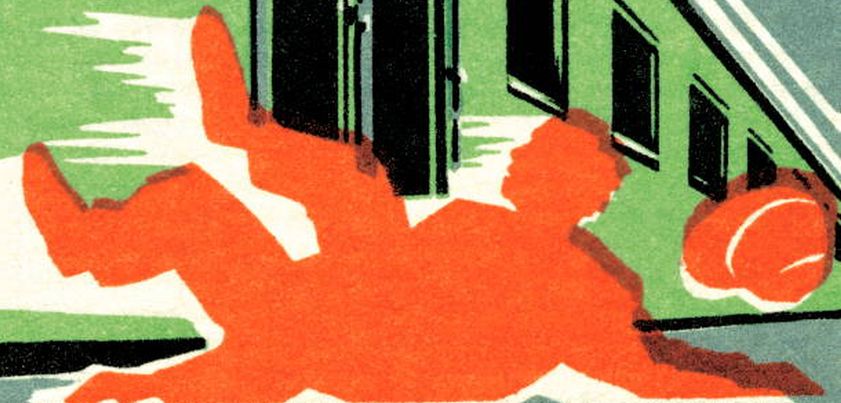 In this story by David Foster Wallace, a man looks back to a day when, as a “slow” nine-year-old student, he daydreamed his way through a Civics class by making up stories based on visual clues he saw while staring out the window. Oblivious to the growing panic of classmates as a deranged substitute teacher wrote KILL, KILL THEM, KILL THEM ALL repeatedly on the chalkboard, he remained sitting after the other students fled. A major theme is fear of disappointment and lack of fulfilment in adult life. Other themes include childhood trauma, violence, pain and loss, time, memory, death. More…
In this story by David Foster Wallace, a man looks back to a day when, as a “slow” nine-year-old student, he daydreamed his way through a Civics class by making up stories based on visual clues he saw while staring out the window. Oblivious to the growing panic of classmates as a deranged substitute teacher wrote KILL, KILL THEM, KILL THEM ALL repeatedly on the chalkboard, he remained sitting after the other students fled. A major theme is fear of disappointment and lack of fulfilment in adult life. Other themes include childhood trauma, violence, pain and loss, time, memory, death. More…
A Sound of Thunder
 What is the most dangerous thing about time travel? According to this story by Ray Bradbury, it is doing some small thing that may change the future. Five men travel back in time to hunt a T-Rex. One of them panics when he sees the monster and steps off a specially prepared path. Because of this, they return to a very different world. The last thing the clumsy hunter hears is a sound of thunder. Themes include arrogance, cowardice, the dangers of technology, connections between past and present, democracy vs. dictatorship, the ethics of game hunting. More…
What is the most dangerous thing about time travel? According to this story by Ray Bradbury, it is doing some small thing that may change the future. Five men travel back in time to hunt a T-Rex. One of them panics when he sees the monster and steps off a specially prepared path. Because of this, they return to a very different world. The last thing the clumsy hunter hears is a sound of thunder. Themes include arrogance, cowardice, the dangers of technology, connections between past and present, democracy vs. dictatorship, the ethics of game hunting. More…
Cell One
 Some websites describe Nnamabia, the young protagonist in this story by Chimamanda Ngozi Adichie, using terms such as ‘a wayward, rebellious son’. This is treating him too kindly. At the beginning of the story, Nnamabia is an entitled, spoiled, manipulative brat… too weak-willed to resist imitating the petty thefts of his peers, yet so cowardly that the only person he is game enough to steal from is his mother. Although he did not deserve the punishment he received at the hands of the so-called Nigerian justice system, he learnt some important lessons and came out of it a man. More…
Some websites describe Nnamabia, the young protagonist in this story by Chimamanda Ngozi Adichie, using terms such as ‘a wayward, rebellious son’. This is treating him too kindly. At the beginning of the story, Nnamabia is an entitled, spoiled, manipulative brat… too weak-willed to resist imitating the petty thefts of his peers, yet so cowardly that the only person he is game enough to steal from is his mother. Although he did not deserve the punishment he received at the hands of the so-called Nigerian justice system, he learnt some important lessons and came out of it a man. More…
A Day Goes By
 First time readers of this narrative from Luigi Pirandello may find it confusing until the last few paragraphs. The story is an allegory of life, contracted into a single day. The day begins as the disoriented protagonist is unceremoniously cast out of a train carriage into the dawn, and ends with him lying on his deathbed surrounded by his children and grandchildren. Themes include alienation (not knowing oneself, lack of self-confidence, exclusion); identity (what makes us who we are – clothes, occupation, recognition, money, possessions, family); and time (the speed at which life appears to have passed as we age). More…
First time readers of this narrative from Luigi Pirandello may find it confusing until the last few paragraphs. The story is an allegory of life, contracted into a single day. The day begins as the disoriented protagonist is unceremoniously cast out of a train carriage into the dawn, and ends with him lying on his deathbed surrounded by his children and grandchildren. Themes include alienation (not knowing oneself, lack of self-confidence, exclusion); identity (what makes us who we are – clothes, occupation, recognition, money, possessions, family); and time (the speed at which life appears to have passed as we age). More…
Anxiety
 In this story from Grace Paley’s activist period, an elderly woman worries about everything from the imminent destruction of the world to the well-being of two children being walked home from school. A father’s shortness with one of the children prompts the woman to call him out. She begins with the alarmist suggestion that people should enjoy life less and think more about the coming doom. She then elicits the cause of the man’s anger (wounded pride), which seems petty compared to the issues she has just raised. Themes: anxiety, global threats, fatherhood, child innocence, adult indifference. More…
In this story from Grace Paley’s activist period, an elderly woman worries about everything from the imminent destruction of the world to the well-being of two children being walked home from school. A father’s shortness with one of the children prompts the woman to call him out. She begins with the alarmist suggestion that people should enjoy life less and think more about the coming doom. She then elicits the cause of the man’s anger (wounded pride), which seems petty compared to the issues she has just raised. Themes: anxiety, global threats, fatherhood, child innocence, adult indifference. More…